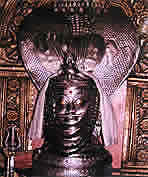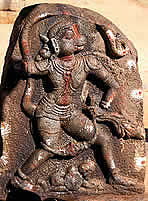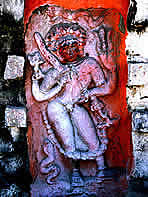| Cults and Practices |
| In pre-Vijayanagara times the Vijayanagara site was a Shaivite tirtha focusing on the worship of Virupaksha and the goddess. Under the Sangama kings, Virupaksha was adopted as the guardian deity of the newly expanding state. Despite the associations of the site with the Kishkindha chapter of the Ramayana (See Mythical Landscape), Vaishnavite cults had little following at the site in the pre or early empire periods. Only in the 15th century did the Vijayanagara kings come to sponsor the cults of Rama and Vitthala. The cult of Vitthala, in particular, grew in strength until the middle of the 16th century when the Vitthala Temple became the foremost religious monument at the capital. During the 16th century the Vijayanagara kings also promoted the Vaishnavite cults of Tiruvengalanatha, Ranganatha (Anantashayana) and Krishna, building large-scale temple complexes for these and other related gods. The acceleration of temple building under the Tuluva kings corresponded to an elaboration in religious rituals and festivals. Royal festivals, especially the Mahanavami, with its mix of goddess worship and martial themes, also added to the magnificence of religious life at Vijayanagara. Meanwhile, resident and visiting ascetics, teachers, and scholars many of them accommodated in mathas, actively served the cause of religion. In addition to these orthodox Hindu cults at Vijayanagara, there was also the worship of minor and folk deities, in particular Hanuman who was conceived as a protective deity in the form of a monkey warrior, Anjanadri. Not only is a hill on the northern periphery of the site with a modern shrine at the summit, named in honour of his mother. Numerous slabs carved with images of Anjanadri, one arm raised in defiance, are found all over the site, especially near gateways ands along roads. This magical protective function is also shared with Virabhadra, a fierce and armed form of Shiva, carvings of whom are also positioned near gateways as well as on the tops of high hills. One of the few temples still in worship within the site is the Uddana Virabhadra, which houses a 3.6 metres high statue of the god. Other fierce deities who received worship at the site include Narasimha. A monolithic statue of this avatar of Vishnu commissioned by Krishnadevaraya himself is found immediately south of the Krishna Temple complex. The worship of goddess continues in the region in several local cults in which animal sacrifice is still practiced. The only temple still in worship in the Royal Centre contains an image of Elamma, a form of Kali. A centre for animal sacrifice, it attracts a few worshipers weekly and larger numbers for weddings and even occasional fire walking ceremonies. Apart from Hindu sects, Jainism and Islam were also practiced at Vijayanagara. Such religious pluralism was characteristic of the rich cultural life at Vijayanagara. One local cult that was practiced within the city was that of satis and heroes, including men, and possibly some women, who died in battle, men who killed themselves as an act of devotion, and women who perished with the body of their dead husbands. Carved slabs and reliefs known as virakal or satikal, found across the site, commemorate these deeds. (Many of these are on display in the Archaeological Museum, Kamalapura.) Pilgrimage was a significant aspect of religious life at the Vijayanagara site, as is evident from Alexandra Mack’s study of Vitthalapura. It remains so today. But while the shrines associated with the Ramayana scattered throughout the Sacred Centre continue to be popular destinations, the majority of pilgrims are content to visit the shrines of Pampa and Virupaksha at Hampi. The most dramatic festival in the ritual calendar of this temple is the annual Kalyanotsava held during the spring season. On this occasion images of Pampa and Virupaksha are paraded in decorated chariots in celebration of their marriage. The ruler of Anegondi continues to play a crucial role in this festival, thereby demonstrating the enduring interdependency of king and god going back to Vijayanagara times. For an introduction to this topic link to Verghese 1995, "Historical, Religious and Archaeological Background"; for the Ramanayana at Hampi link to Verghese 1995, "The Ramayana Tradition"; for more on the religious associations of the site see Verghese 1995, Religious Traditions at Vijayanagara and Verghese 2000, Archaeology, Art and Religion; for pilgrimage, see Mack 2000 Spiritual Journey, Imperial City; all in BibliographyFor thechariot festival in Hampi village, see Das 1996,"Preliminary Findings on Devine and Royal Themes" in Project Publications. For organization of sacred space in the region, link to Das 2006, "Mystic Gateways", and to Malville and Fritz 1996, "Astronomical Studies I, Sacred Hills"; for the transfortion of sacred space associated with the Virupaksha Temple link to Wagoner 1991, "Architecture & Mythic Space at Hemakuta Hill". |
|
|||||||



